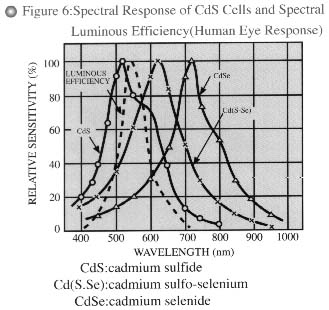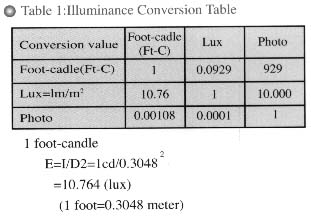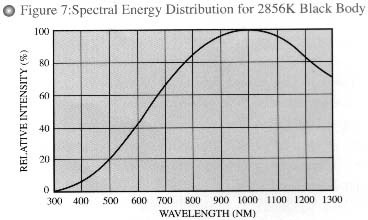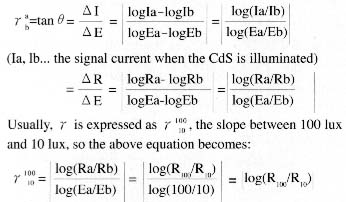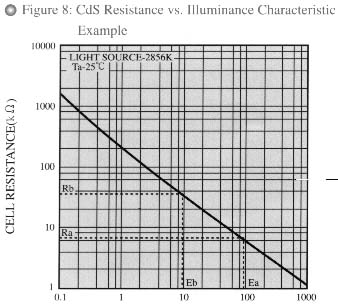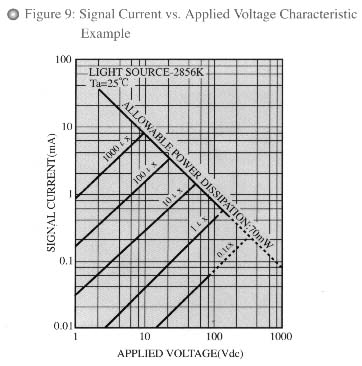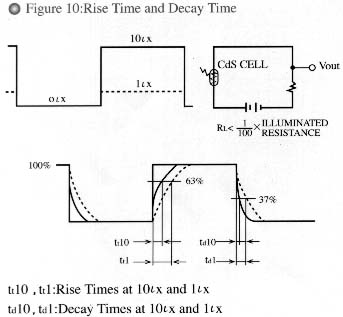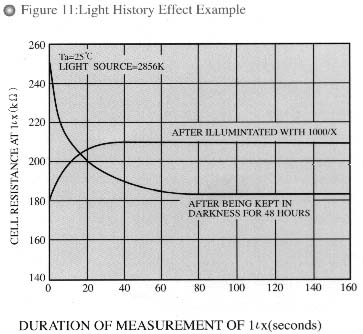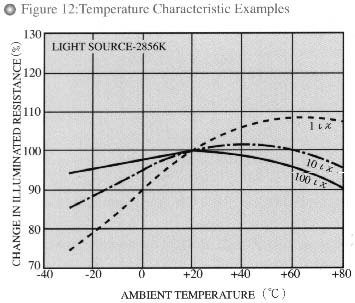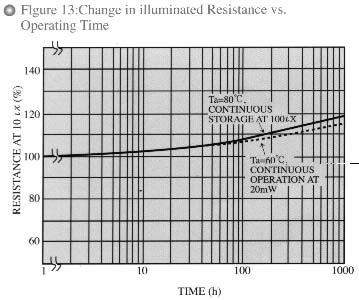OCTSENS TECH CO., LTD.
Construction
Characteristics of Cds Cells
Photosensitive devices
can be divided into photovoltaic devices
Here we will explain briefly the basic operating principles, fabrication
and structure of CdS cells.
¡@
PHOTOCONDUCTIVE EFFECT
Figure 1 is a schematic diagram of a CdS cell and its operation circuit.
An electrode is set at each end of the photoconductor. In darkness, the
photoconductor resistance is very high, and when a voltage is applied, the
ammeter shows only a small dark current. This is the CdS photoconductor's
characteristic thermal equilibrium current. When light is incident on this
photoconductor, a current (I) flows. Figure 2 shows the current that flows
when the amount of light is increased.
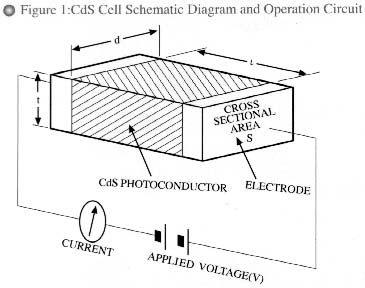
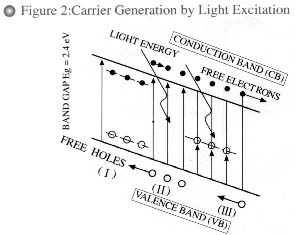
Here are the basic principles of the photoconductive effect.
( £L ) Directly beneath the conduction band of the CdS crystal is
a donor level and there is an acceptor level above the valence band. In
darkness, the electrons and holes in each level are almost crammed in place in
the crystal and the photoconductor is at high resistance.
( £L£L ) When light illuminates the CdS crystal and is absorbed by
the crystal, the electrons in the valence band are excited into the conduction
band. This creates pairs of free holes in the valence band and free electrons
in the conduction band, increasing the conductance.
( £L£L£L ) Furthermore, near the valence band is a separate acceptor
level that can capture free electrons only with difficulty, but captures free
holes easily. This lowers the recombination probability of the electrons and
holes and increases the number for electrons in the conduction band for N-type
conductance.
The increase in conductance in ( £L£L ) requires that the light energy
be greater than the bank gap Eg. For CdS with a bank gap of 2.41
eV, the absorption edge wavelength £f is
£f=
c/ £o =hc/Eph=1240/Eg~515( nm )
Where Eph :photon energy (h £o )
h: Planck's constant
£o: light frequency
C: speed of light
Therefore, the CdS crystal absorbs light with a wavelength shorter than
515 nm and lets light with a wavelength longer than
515 nm be transmitted. Therefore, the photoconductor's absorption edge
wavelength determines the spectral response characteristic on the long
wavelength side. In the actual spectral response characteristic shown in
Figure 3, the sensitivity of CdS drops at wavelengths shorter than 515 nm.
This is because at short wavelengths, the light is absorbed near the surface
of the crystal, increasing the local charge density and inducing electron hole
recombination, and also because there are lattice defects at the crystal
surface, they promote the recombination.
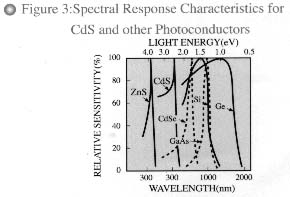
Until the carries generated in ( £L£L ) and ( £L£L£L ) recombine,
electrons are injected from one electrode and pulled out by the other.
When these carriers last longer and they move more, the conductance
increases greatly. The conductance £G p is given by the following equation.
£Gp=ef( £gn £nn+ £gp £np)
Where £gn, £gp: free electron, free hole movement (cm/V £»
sec)
£nn, £np: free electron, free hole life (sec)
f:
number of generated carriers per
second per cubic volume
For a CdS cell, £gn £nn>>£gp £np and conductance by free holes can
be ignored. Then it becomes an N type semiconductor. Thus,
£Gp=ef £»
£gn £nn
Here, the gain G is defined as how many electrons flow between the
electrodes due to excitation by one photon in the CdS photoconductor (until
the carrier lifespan is over).
G=
£nn /tt
Where tt: tranist time between electrodes =£L2/V £gn
£L: distance between electrodes
V: voltage applied
Therefore,
G= £gn £nn V /£L2
If, for example, £gn=300 cm2/V £»sec,
£nn=10-3 sec, 1=0.2mm, and 1.2V, then the gain is 900. This means
that there is multiplication in the CdS photoconductor and that the CdS is
highly sensitive.
The
sensitivity of CdS is the change in resistance, i.e. the change in current in
response to change in light. As Figure 1 shows, if the distance between the
electrodes is 1 the cross-sectional area of the photoconductor is S, and the
voltage applied is V, then from Ohm's law:
£G£L¡Û£Gp.S£»V/1=£Gp£»t£»
V/1
If the conductance £Gp and
the photoconductor thickness t are held constant, then,
£G£L¡Û
d/1¡÷resistance
¡µ
R
¡Û 1/d
This 1/d is an important factor in designing the electrode
configuration. In other words, the shorter distance between the electrodes and
the greater the electrode length, the higher the sensitivity and the lower the
cell resistance. Thus, the electrode patterns for high-sensitivity CdS cells
consist of many
STRUCTURE
The manufacturing process of the photoconductive layer into the sintered
type, single crystal type and evaporated type can divide CdS cells. Of these
different types the sintered type offers high sensitivity areas, a large mass
production effect, and relatively superior production profitability, so AGI
uses the sintering film fabrication method.
Here is the process
for making sintered CdS cells. Impurities and a fusing agent for encouraging
crystal growth are added to highly pure CdS crystal power and this mixture is
dissolved in water. The resulting solution is applied to CdS ceramic substrate
and dried, and then it is sintered in a high-temperature oven to form multiple
crystals. In this way, a thick layer with the photoconductive effect is
formed.
Then, lead terminals
are introduced to the CdS substrate and the CdS is packaged. (Figure 4 and
photo 1 shows an example of the structure of a plastic-coated CdS cell.)
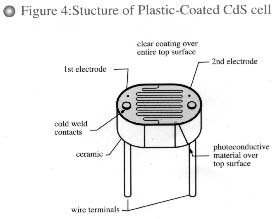
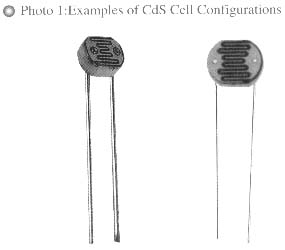
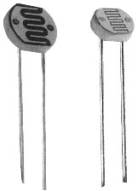
CHARACTERISTICS
In the selection of a suitable CdS cell, the characteristics required by
the functions of the circuit in which the CdS cell is to be used are
important; in general, there are analog uses such as light measurement and
digital uses such as on-off switching.
Use in digital circuits such as switching requires a fast response and a
high ratio between illuminated resistance and dark resistance. For
illumination and exposure meter and other devices that measure brightness, the
sensitivity, the slope of the resistance vs. illuminant (gamma), and the spectral response
characteristic are important. Therefore, understanding the various
characteristics of CdS cells presented below is important for selecting the
night CdS cell for your application.
MAXIMUM RATINGS
The maximum ratings given in this catalog are absolute maximum ratings.
This means that these are the values, which are not to be exceeded even
momentarily. Values above the maximum rating may break down the CdS cell and
lower its performance, so take adequate care in circuit design to avoid them.
¡´
Allowable Power Dissipation
Allowable power dissipation is the limiting value of power consumption
of a CdS cell when it is operated in a circuit. If a CdS cell is operated
under conditions that cause its allowable power dissipation to exceed,
deterioration of performance is hastened and the photoconductive surface can
be damaged or broken down. Therefore, this parameter must be held within the
ratings in the same manner, as are the applied voltage and ambient
temperature. This allowable power dissipation applies to total illumination of
the photoconductive surface of a CdS cell, so when only part of the surface is
used, the allowable power dissipation must be reduced in proportion to the
illuminated surface area.
The allowable power dissipation figures in this catalog are for a
temperature of 25¢J.
When these CdS cells are used at higher ambient temperatures, the power
consumption must be reduced, as the dreading shown in Figure 5. So this point
must be taken into consideration as well.
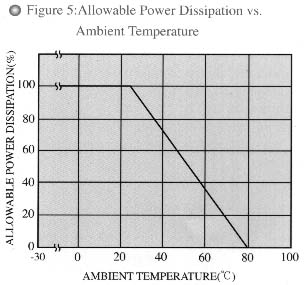
¡´
Ambient Temperature Range
Unless otherwise specified, the maximum rated ambient temperature range
is for CdS cell operation and storage. Operating or storing a CdS cell outside
of this temperature range reduces its performance. Never keep or operate Cds
cells at temperature exceeding the maximum rating. It is suggested to keep CdS
cells at normal room temperature and humidity before using them.
Even within the ambient temperature range, the cell resistance,
response, and other characteristics vary somewhat with the temperature, so
take this into consideration.
¡´
Applied Voltage
The maximum applied voltage is the voltage that can be applied between
the two terminals of a CdS cell. When the CdS cell resistance is at its
maximum (the equilibrium dark resistance in total darkness), the voltage that
can be applied between the CdS cell terminals is also at its maximum. Never
let the applied voltage exceed the maximum rating. If the power consumption
increases during CdS cell operation, the rating of allowable power dissipation
should take precedence over the applied voltage rating.
